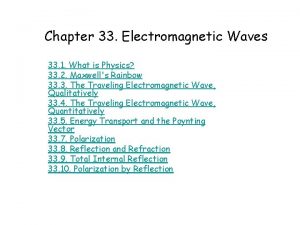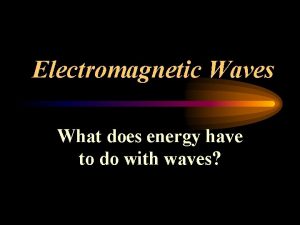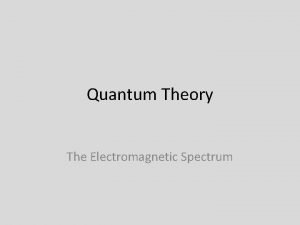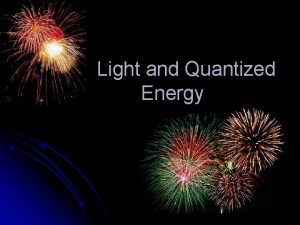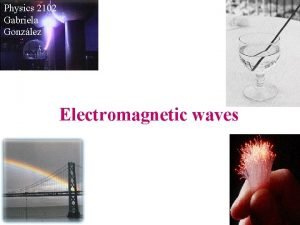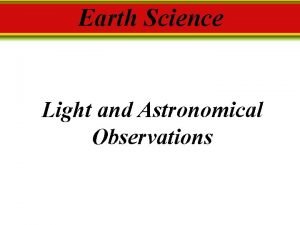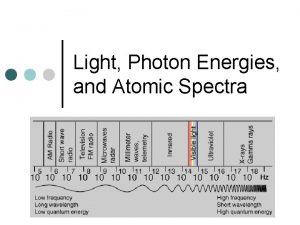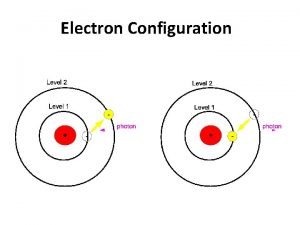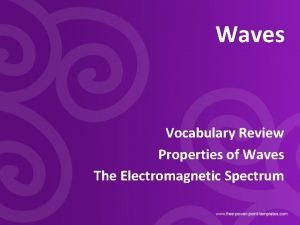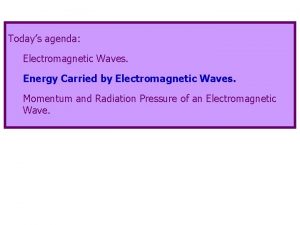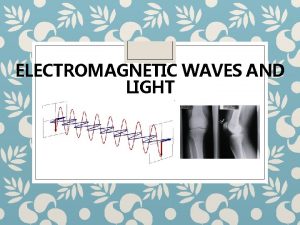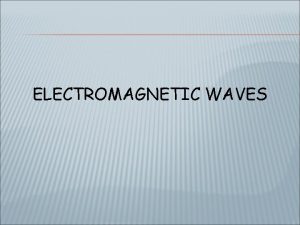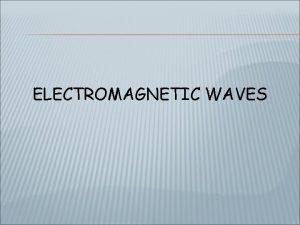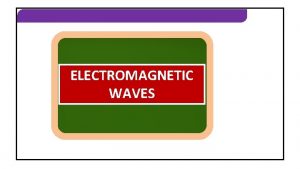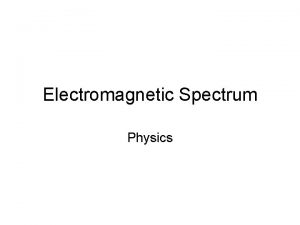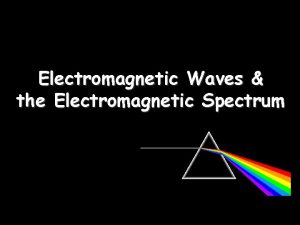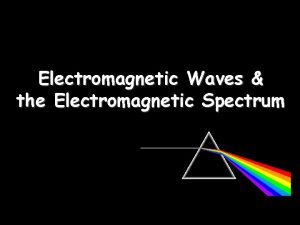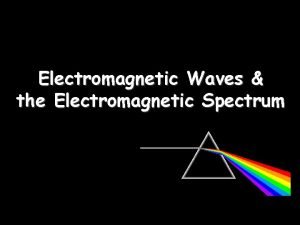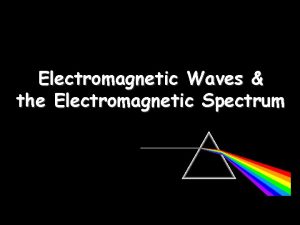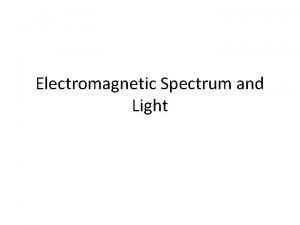Electromagnetic Radiation Waves a review p Most waves


















- Slides: 18

Electromagnetic Radiation

Waves… a review p Most waves are either longitudinal or transverse. p Sound waves are longitudinal. p But all electromagnetic waves are transverse…


p Electromagnetic Spectrum—name for the range of electromagnetic waves when placed in order of increasing frequency RADIO WAVES INFRARED RAYS MICROWAVES ULTRAVIOLET RAYS VISIBLE LIGHT GAMMA RAYS X-RAYS

Electromagnetic waves p Produced by the movement of electrically charged particles p Can travel in a “vacuum” (they do NOT need a medium) p Travel at the speed of light c= 3. 0 x 108 m/s p Also known as EM waves

What is the relationship between frequency and wavelength? wavelength INVERSE (as one goes up, other goes down)

Radio waves p Longest wavelength, lowest energy p Uses: n TV broadcasting n AM and FM broadcast radio n Heart rate monitors n Cell phone communication n MRI (MAGNETIC RESONACE IMAGING) p Uses Short wave radio waves with a magnet to create an image

Microwaves p Wavelengths from 1 mm- 1 m p Uses: n Microwave ovens n Bluetooth headsets n Broadband Wireless Internet n Radar n GPS

Infrared Radiation p Wavelengths in between microwaves and visible light p Uses: n n n Night vision goggles Remote controls Heat-seeking missiles

Visible light Only type of EM wave able to be detected by the human eye p Violet is the highest frequency and energy light p Red light is the lowest frequency light and lowest energy p

Ultraviolet p Shorter wavelengths than visible light p Uses: n Black lights n Security images on money n Harmful to living things Used to sterilize medical equipment p Too much causes sun burn p p Extremely high exposure can cause skin cancer

X-rays p Tiny wavelength, high energy waves p Uses: n Medical imaging n Airport security p Moderate dose can damaging to cells

Gamma Rays p Smallest wavelengths, highest energy EM waves p Uses n Sterilizes medical equipment n Cancer treatment to kill cancer cells p Kills nearly all living cells.

Waves or Particles • Electromagnetic radiation has properties of waves but also can be thought of as a stream of particles. n Example: Light p p Light as a wave: Light behaves as a transverse wave which we can filter using polarized lenses. Light as particles (photons): When directed at a substance light can knock electrons off of a substance (Photoelectric effect)

Emission of Light p Quantum – minimum amount of energy that can be gained or lost by an atom; can be referred to as a packet of energy p Photon – packet of light energy (quantum)

Light & Energy 5. 1 Electrons & Light p As energy is absorbed, the electrons move from their ground state (original energy level) to an excited state (higher energy level) energy levels Initial position nucleus ) 1 ground state ) 2 ) 3 ) 4 Final position ) ) ) 5 excited 6 state 7

Light & Energy 5. 1 Electrons & Light p Electrons are unstable in their excited state, so they return to the ground state by releasing energy. During this return, light is emitted! energy levels Final position nucleus ) 1 ground state ) 2 ) 3 ) 4 Initial position ) 5 ) ) 6 7 excited state

Light & Energy 5. 1 Spectra of Light p Emission Spectra - A set of frequencies of the electromagnetic waves emitted by atoms of the element n n n Shows all the wavelengths of light that are emitted Spectroscope – instrument used to see the emission spectra Unique to each element
 Parts of a longitudinal wave
Parts of a longitudinal wave Light is electromagnetic radiation true or false
Light is electromagnetic radiation true or false Mechanical waves and electromagnetic waves
Mechanical waves and electromagnetic waves Difference between electromagnetic waves and sound waves
Difference between electromagnetic waves and sound waves Mechanical waves and electromagnetic waves similarities
Mechanical waves and electromagnetic waves similarities Mechanical vs electromagnetic
Mechanical vs electromagnetic Mechanical and electromagnetic waves similarities
Mechanical and electromagnetic waves similarities Electromagnetic and mechanical waves
Electromagnetic and mechanical waves Formula for intensity of electromagnetic wave
Formula for intensity of electromagnetic wave Facts about electromagnetic radiation
Facts about electromagnetic radiation Conclusion of electromagnetic spectrum
Conclusion of electromagnetic spectrum Types of radiation in the electromagnetic spectrum
Types of radiation in the electromagnetic spectrum Energy density of electromagnetic wave
Energy density of electromagnetic wave Which telescope detects invisible electromagnetic radiation
Which telescope detects invisible electromagnetic radiation Electromagnetic frequency spectrum
Electromagnetic frequency spectrum When electromagnetic radiation of wavelength 300
When electromagnetic radiation of wavelength 300 Genchem
Genchem A health inspector is measuring the intensity of a sound
A health inspector is measuring the intensity of a sound Energy density of em waves
Energy density of em waves








